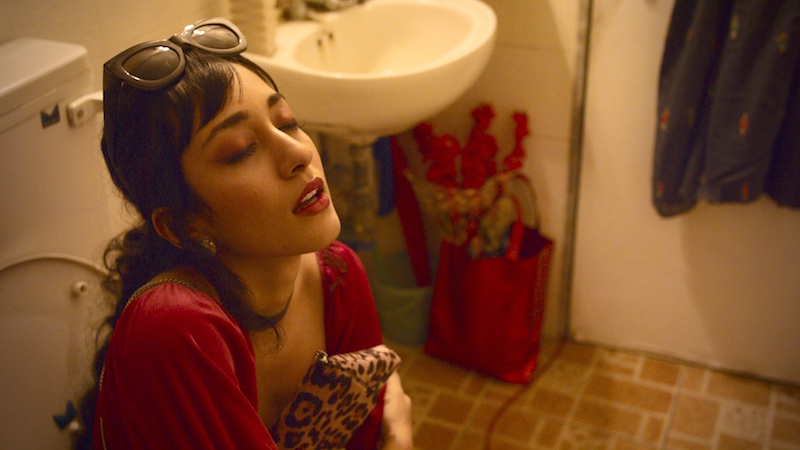A scene in our film Mumu Shelley (2021) has Mumu (Pubali Sanyal) drop a vessel of cooked rice on the kitchen floor. In keeping with Mumu’s character, it was a huge vessel containing 2 kgs of rice. I planned the scene at the end of the shift. Of course, the actual drop happens off-screen as we could not take the risk of Pubali getting hurt by the vessel or the hot rice. But later, after a 3 am pack-up, Vivek Shah (my husband and the DOP) and I were cleaning the kitchen floor of every vestige of cold sticky rice for a good hour before going to bed.
A small, independent film, at the best of times, always involves a good amount of ‘cleaning of cold sticky rice’. A doubling up of responsibilities and roles. Vivek and I have been used to making films on shoestring budgets right since our FTII days. Our first-year continuity exercise at FTII trained all of us to exchange roles on a film set without complaint. Since then, all the films Vivek and I have worked on together, 150 Seconds Ago (2002), Lilkee (2006) and Kaphal (2013), have required us to take on additional responsibilities apart from those of DOP and writer/director.
On Mumu Shelley, despite his professional commitments on other bigger projects, Vivek has been the DOP, carpenter, electrician, set guy and all-purpose driver. I have had to be the chef, cleaner, production manager, props person, accountant and runner. And Aiman Mukhtiar, our daughter, besides writing the script, and acting in it (as Shelley), also had to be production designer, costume designer and assistant director.
Making a film in the middle of a pandemic, only constricted our parameters even more. Making the film with our own money only increased our responsibilities that much more. Shooting the film in our own home only made the chaos crazier.
None of us in the crew had gone through a lockdown of this nature in our lifetimes. Coming from that experience, the film shoot, small-scale as it was, became a lifeline of hope and joy for all of us. After months of isolation, our home was filled with people, some of them friends and old associates, some new entrants to our circle. There was tension in the air, the tension of work, of a shoot, of schedules, of call-times and wraps. The welcome tension of a ‘normal’ life.
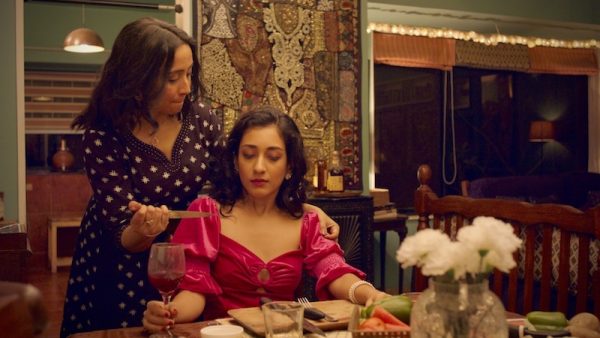
It was the urge to move towards this ‘normalcy’ that gave birth to Mumu Shelley. Aiman, Vivek and I had shot a short film in Goa in Feb 2020 just a little before the lockdown. And though we had to abandon that project due to various reasons, we were restless to shoot something, to do a small film within what was possible for us. The Goa shoot taught us some valuable lessons on what we could manage best with our limited resources. Aiman took up the challenge of writing a story and script that could be done within our apartment with old friend and associate Pubali and herself.
Since coming back from the Lee Strasberg Theatre and Film Institute in New York, Aiman had often discussed with me the idea of creating work with her women actor friends and women directors. There are always so many conversations that take place between Aiman and me, between us and our women friends, our women relatives, younger and older. And then there are conversations that we are all conditioned to mute. Aiman and I are keen to create narratives that reflect our situations, our lives, but staying away from the usual tropes that women are normally portrayed within. Stories that are real, yet reflect the absurdity, the comedy of our situations that attract both Aiman and me as the lens through which we see the world.
Coming from two ends of the age spectrum, our two very different life experiences collide into a more complex narrative than the one each of us creates on our own. However, though we have similar tastes in genre, style, form, it is not an effortless process to work together, just as it is not with Vivek, my cinematographer since FTII. All of us have strong opinions, we argue a lot about our ideas. But at the end of the day, we also trust each other’s opinions a lot and are happy to let each person be the master/mistress of their own fortress, so our roles remain clearly demarcated. And that I think, is what makes our working together, over and over again, possible.
Aiman had shot a short improv comedy sketch in the US with her friends about a girl coming out to her father. Since then, she had been thinking of a coming out story where the stakes were much lower, coming out to a stranger. She thought of the two characters Mumu and Shelley and the situation they were in. She shared the concept with me, and I liked it a lot. We spoke about it at length for some time, and Aiman wrote the script of Mumu Shelley.
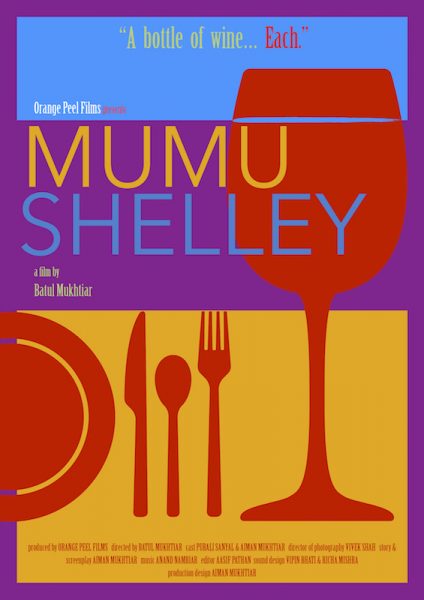
Mumu Shelley looks at Shelley, 23, a tacky small-town lesbian who craves for her girlfriend, Mishti, to come out to her family. Mishti promises her that her older cousin, Mumu, will help them. But when Shelley is forced to ‘hang out’ alone with Mumu, at a party that never takes off, she finds the neurotically perfectionist home-maker not as ‘cool’ or ‘together’ as she claims to be. While Mumu and Shelley judge each other’s lives aggressively, they also realize dark comedic truths about their own.
As we discussed the script, Pubali added some colors to Mumu with her memories of her family. I began to think of Mumu as a modern version of the protagonist of Satyajit Ray’s Charulata (1964). Though the story in itself is not a lockdown story, to me, both Mumu and Shelley seemed to be locked down as all of us often are – at different phases in our lives, within our own heads, inside our own pain. This mental lockdown that Mumu and Shelley felt also began to dictate other decisions I took for the film. Like for instance, the old lecherous neighbor, who Mumu and Shelley both respond to visually and verbally, but whom we never see. Or the fire that breaks out in the old man’s house, which also we don’t see. It seemed to me that the world of Mumu’s apartment must be as isolated as her, cut off from the city around her.
While we rehearsed over two months, Aiman had been silently working on variations on her costume and look. One day, she came out of her room, wearing a fringe, a wine-red velvet dress and high heels. Her appearance and body language immediately helped me to put my finger on the pitch and tone of the film. In that instant, I realized that the film could not be a very realistic interpretation of the text, but needed to be slightly absurd, slightly over-the-top.
Both Pubali and Aiman with their training in theatre, were able to conceive and add a lot of physical choreography to their scenes. Vivek and I were clear that there had to be a lot of movement within the film and that the confined space of the apartment should be explored in a way that would not become monotonous but have several defined spaces to keep the visual interest alive. He had set up a light grid on the ceiling over all the shooting zones, to give maximum freedom to the actors to move within the scene. Vivek and I also planned the camera angles and the shots during rehearsals, with and without the actors, so that we could avoid any wastage of time during the limited number of days we could afford to shoot.
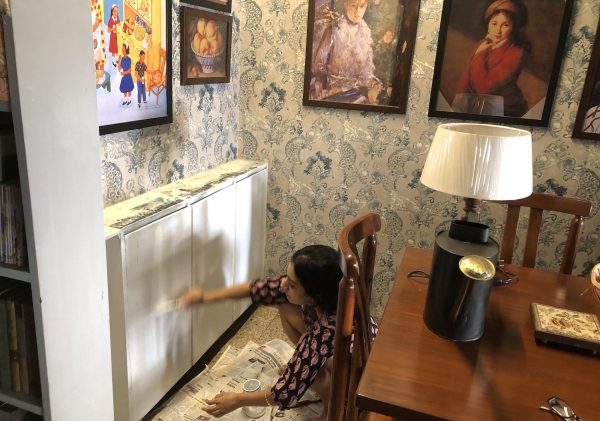
The choreography and camera angles became more defined with the ‘building’ of the set. The art direction was very specific in Aiman’s mind – the idea of creating an apartment suffocating, stagnant with its over-stuffiness and over-decoration. One with an excess of food, furniture, a surfeit of textures and colours. We needed three houses worth of furniture to create that claustrophobic stuffiness including furniture from Pubali! Some props like fridge magnets from different countries to subtly underline Mumu’s boasting of foreign travels and gold-rimmed crockery for the all-important dining table scenes were borrowed from friends. Walls were lined up with several prints by women painters of women, their faces looking down at Mumu and Shelley. Some items were bought including table mats, rugs, cushion covers and over-decorative wall paper in blue and gold. The walls were painted deep blue. All of it a gaudy, ornamental frame for Shelley’s wine-red dress, and Mumu’s staider black and white outfit. Vivek and Aiman did everything from small bits of carpentry, to re-painting some furniture.
The red of the endless glasses of wine came from copious amounts of beetroot juice that I made. The film revolves around the tons of food being cooked and served by Mumu. Creating the kitchen, keeping it overly stocked with stacks of vegetables and other provisions, cooking kilos of mince and dal for the kebab scenes and maintaining the continuity of it all through 6 hectic shoot nights, while running our own house and kitchen during the day time, was a feat in itself. Everything was in excess but for some strange reason, while ordering the kebabs for the dining table scene, I miscalculated our requirement and ordered only three packets – 18 kebabs in all. With a few being broken and others consumed during every take and every change of camera angle, I began to panic. It was the middle of the night and I was desperately counting each and every kebab, admonishing the actors from touching anything beyond the absolutely necessary. Fortuitously, when we had to shoot the halwa scene, I made sure there was enough cooked for the entire crew. It also made for a warm, sweet midnight feast for all of us in the middle of the shoot.
Doing comedy is always a challenge and with the additional restraints of location and only two characters, the fear of it falling absolutely flat was very real. The edit of the film, competently helmed by Aasif Pathan who had worked with me earlier as assistant editor on Kaphal, finally assuaged the very real fear I had had – of pulling off the quirkiness which I was striving for. As work progressed, I also toned down the more gimmicky ideas we had played with earlier. Like captions or chapter breaks that seemed to me to break the narrative of the film. I wanted to pitch the film towards the absurd but without alienating us from the characters.
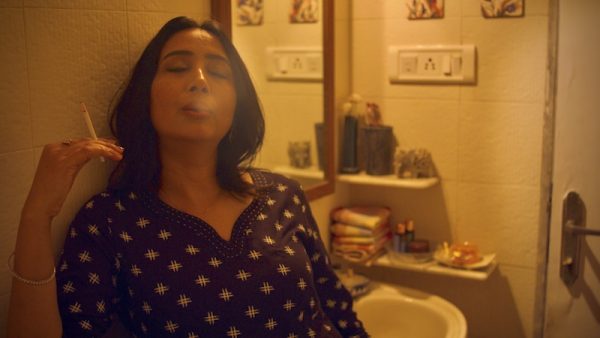
I wanted the closeness of the set, and Mumu’s world to be emphasized by the sound design. Sound designer, Richa Mishra, and I worked hard to move away from a realistic ambience track of the world outside to contain the sound as much as we could to within the apartment. We decided to use foley sound, additional ambience effects, and music effects, to heighten the emotion, rather than use a realistic sound perspective. Our music director, Anand Nambiar, deftly caught my sundry ideas ranging from silent Chaplin film-like music to jazz and old 50s Hindi film music to flamenco and came up with something that had exactly the energy and spirit I was looking for. Since almost all the post work was done remotely with Aasif working from Panvel, Richa from Mumbai and Anand from Kochi, the back-and-forth allowed each one of us more time to process our decisions. Each one of them patiently tackled the hundreds of notes that I sent them, not stopping work on the film until we were all satisfied.
Somehow, the smaller the film and the more challenging its making, the camaraderie and the generosity of the team members seems to increase.
On the shoot, each person who came in had to be accounted for. We needed to keep the crew to a minimum due to Covid and also to keep the already restricted space within the apartment as uncrowded as we could. Our old associate, Tejash Shah of Accord Equips, agreed to give us the camera equipment with just one attendant. But we had an additional requirement – that the attendant also be able to work as a boom operator since we had convinced Richa we could not add yet another person into the flat. Sonu, who came with the camera, had never operated the boom before but he learned willingly from Richa. Every once in a while, he would get distracted and the boom would drop into frame, but a chorus of “SONU!”s would quickly bring him back to attention! Komal Singh and Ruby Irani, who came in for makeup and hair, read the script in the make-up room i.e. Aiman’s bedroom. They were so excited by it that they then spent their time glued to the monitor with me. Occasionally, Vivek would ask one of them to hold up a reflector or switch a light on and off and they were happy to participate. Vivek’s long-standing associate, Rajesh Paliwal, a focus puller by profession, willingly pitched in as camera assistant, electrician and clap boy.
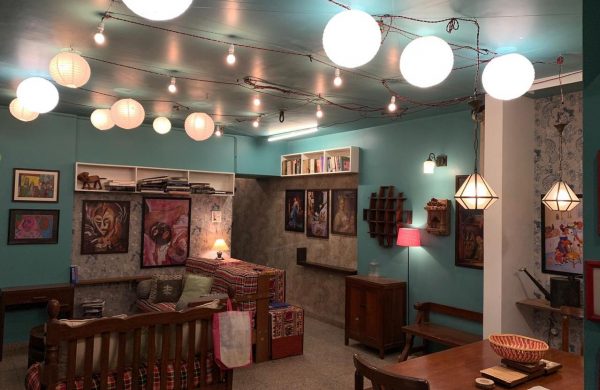
We had not planned sync sound, because it was unaffordable. But our sound designer friend, Vipin Bhati, who had worked with us earlier on Lilkee, heard we were shooting a small film. He called me of his own accord and bullied me into taking his assistant, Richa, on board, so that we could do sync sound. He generously loaned us his sound equipment and later, his studio to complete our sound work. Despite his other professional commitments, he supervised the post with Richa, double-checking the outputs at every stage. Similarly, Mahak Gupta insisted that she would do the color correction despite our meagre budget. Sid Meer of Bridge PostWorks and Mahak gave generously of their resources and time to complete the film and remove its Work-In-Progress tag. The film looks as luscious as we had imagined it.
Yes, it was a challenge for all of us to work under the circumstances but we wanted to create a film that did not reflect those challenges. And I think we all managed to do that together. It was a crazy time, it was a fun time and it made the pandemic bearable.
Mumu Shelley is currently streaming on Movie Saints in their Recommends Section (https://www.moviesaints.com/
The trailer of the film can be viewed here – https://vimeo.com/570150236.
Batul Mukhtiar works as a filmmaker in Mumbai. She also writes short stories and blogs at https://batulm.wordpress.com.


